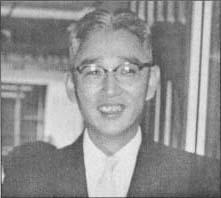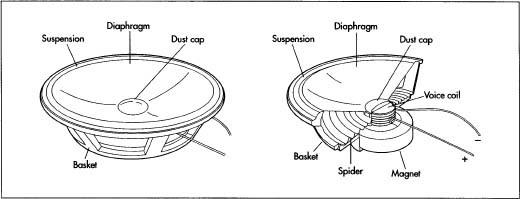Stereo Speaker
Background
A loudspeaker or speaker is a device that converts electrical energy waves into mechanical energy waves or audible sounds. Sound is produced by the vibration of an object. This vibration sets up a series of ripples or waves much like what is seen when a stone is thrown into a pond. Speakers reproduce sound waves (or audio) at various frequencies. The frequency is the rate at which the particles in the air vibrate. Sound that the human ear can hear is from about 20 hertz (Hz) to 20,000 Hz or 20 kilohertz (kHz). Speakers are used in all types of communications and entertainment equipment such as radio and television receivers, tape recorders, telephone answering machines, baby monitors, and stereo home entertainment systems
History
The basic principle of a dynamic speaker has changed little since it was patented by Ernst Siemens in 1874. Siemens described his invention as a means for obtaining mechanical movement of an electrical coil from electric currents that flowed through it. The original intent of his invention was to move a telegraph arm. Alexander Graham Bell applied the principles of Siemens device to the telephone two years later. Thomas Edison is credited with inventing the loudspeaker as it is known today. It consisted of a flexible diaphragm (cone) attached to the throat of an acoustical horn.
The cones of early loudspeakers used various materials such as thin metal sheets, leather, and paper. Paper was (and still is) used in the construction of speaker cones because it is cheap and readily available.
Raw Materials
The dynamic speaker has not changed in decades. The frame is made from stamped iron or aluminum. The permanent magnet is a ceramic ferrite material consisting of iron oxide, strontium, and a ceramic binder. The cone, surround, and spider are made of treated paper coated with an adhesive glue. The voice coil consists of a plastic bobbin with fine gauge insulated copper wire wound around it.
Design
The most common speaker is the dynamic speaker. It consists of a frame, permanent magnet, soft iron core, voice coil, and cone. The frame supports the cone and permanent magnet assembly. The voice coil consists of an insulated wire wound around a plastic bobbin. One end of the bobbin is attached to the cone and the body of the bobbin slides over the soft iron core.
The wires from the voice coil are connected to an audio amplifier. When electrical audio signals from the amplifier are applied to the voice coil, an electromagnetic field is produced around the voice coil. This causes the voice coil to move back and forth along the soft iron core which aids or opposes the magnetic field produced by the permanent magnet. The movement of the voice coil causes the attached cone to vibrate and produce sound.
There are four major types of speakers: full-range, tweeter, midrange, and woofer. The full-range speaker can reproduce most of the audio sound spectrum. However, a single speaker cannot accurately reproduce the entire audio frequency range of the human ear. Therefore, other speakers were designed to overcome the limitations of the full-range speaker.
The tweeter is designed for the higher audio frequencies or treble sounds in the 4-20 kHz range. They are very small, usually around 2 in (5.1 cm) in diameter or under. The midrange speaker reproduces sounds in the 1,000 Hz to 10 kHz frequency range. Their size ranges from 2 in to 8 in (5.1—20.3 cm) in diameter. The woofer reproduces the bass or very low sounds in the 20-1,000 Hz frequency range. A subwoofer can extend this to as low as 3 Hz. Woofers range from 4 in to 15 in (10.2-38.1 cm) in diameter with 10-12 in (25.4-30.2 cm) in diameter being the most common.

Akio Morita was born January 26, 1921 in the Japanese village of Kosugaya. Morita would have been the fifteenth generation heir to his family's 300 year-old sake business, but instead entered the prestigious Eighth Higher School as a physics major.
Rather than be drafted into World War II, Morita entered Osaka Imperial University, agreeing to serve in the Japanese Imperial Navy after graduation. There Morita met Masura Ibuka, an electronics engineer. After the war, Morita and Ibuka created the Tokyo Telecommunications Engineering Corporation with only $500 and 20 employees. In 1953, Morita bought the rights to the transistor, a miniature electronics circuit developed by the American company Bell Laboratories and considered to be impractical. Within two years, Morita and Ibuka created the AM transistor radio. In an-other two years, they began to produce the pocket-sized transistor radio, AM-FM transistor radio, and first all-transistor television set.
In 1958, Morita changed the company's name to Sony Corporation and moved to New York to set up United States operations. Sony became the first foreign-owned business to offer stock for sale in the United States, and in 1970 became the first Japanese company listed on the New York Stock Exchange.
During the 1980s and early 1990s, Morita wrote two books dealing with careers in business and international business trade: Made in Japan (1986) and The Japan That Can Say No (1991). In 1994, he retired at age 73, after suffering a debilitating stroke. Morita died of pneumonia in Tokyo on October 3, 1999.
The Manufacturing
Process
- The permanent magnet is constructed by mixing iron oxide with strontium and then milling the compound into a very fine power. The power is mixed with a ceramic binder and then closed in a metal die. The die is then placed in furnace and sintered to bond the mixture together.
- The frame is constructed from an aluminum or steel sheet. The sheet arrives at the plant preformed. It is then placed on a conveyor belt and transported to a cutting machine that used a hydraulic press to cut holes in the sheet to allow free air movement from the cone. The sheet is then formed by a hydraulic press that forces the sheet into a die of the desired shape. Mounting holes are then drilled at their proper locations.
- The cone, surround, and spider are individually formed out of composite paper and then glued together as an assembly.
- The voice coil is built by winding many turns of very fine insulated copper wire on a plastic bobbin. The bobbin and voice coil assembly is glued to the dust cap of the cone assembly.
- The frame, soft iron core, and permanent magnet are bolted together as an assembly.
- The cone assembly is then attached to the frame assembly by first manually gluing the spider to the base of the frame and then gluing the surround to the top of the frame.

Quality Control
Inspectors monitor all steps of the manufacturing process. The permanent magnet is checked for chips or cracks. The paper cones are inspected for flaws or holes in the material, and proper gluing of the cone assembly. The entire assembly is inspected for overall quality and adherence to specifications.
The final speaker assembly is connected to an audio generator that tests the frequency response and power capabilities of the speaker to insure that in produces sound within the required specifications.
Byproducts/Waste
Scrap metal from the frame and scrap paper from the cone are sent to recycling plants for reclamation. Exotic materials such as strontium must be disposed of according to government regulations.
The Future
The industry is constantly experimenting with raw materials to improve speaker sound quality, frequency response, and power output. New technologies are being developed in the form of a direct-drive speaker that uses no cone.
Where to Learn More
Books
Prompt Publications. Speakers for Your Home and Automobile. Indianapolis: 1992.
Other
McIntosh Laboratory Web Page. December 2001. < http://www.mcintoshlabs.com >.
Ernst S. Sibberson